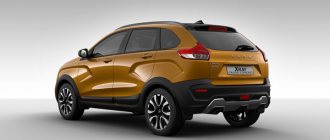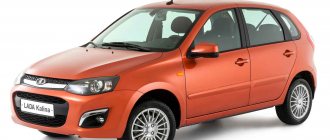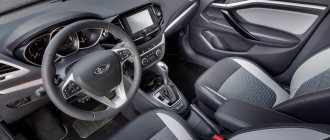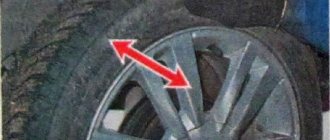Production of the Lada XRay at AvtoVAZ began on December 15, 2015, and sales began on February 14, 2016 at 120 dealers in 56 cities. During 2016-2018 the car was mercilessly tested by many car owners and based on their reviews we can talk about the pros and cons of Xray.
Almost three years that have passed since the start of sales have allowed the owners of the purchased cars to test them in a variety of operating conditions, and this testing not only confirmed the declared ones, but also revealed shortcomings that the concern is working on already during the production process.
From the many different reviews from car enthusiasts, we will select the negative ones, consider their reasoning and group them into areas:
- Body;
- Trunk;
- Salon;
- Engine;
- Optics;
- Transmission;
- Brake system.
Body
Lada Xray was expected since 2012, moreover, as a crossover, but, 3 years later, to the disappointment of those expecting the presentation, it still resembled a small hatchback with increased ground clearance to 195 mm and only front-wheel drive.
The spectacular profile of the sides of the Lada X Ray, the embossing of the doors and wings has a downside - the difficulty of restoring oval contours on these body parts after damage.
There are no roof rails on the XRay roof, so it is not possible to install a roof rack on top, other than a rare universal one from the 60s, and the price of foreign-made luggage boxes is several tens of thousands of rubles.
The hood in the open position is fixed low - by a short strut, which makes access to the engine compartment inconvenient - you have to bend over.
The body sills are not protected by any coating underneath, and as a result of the abrasive effect of gravel flying from under the wheels (common to a crossover), they quickly begin to corrode.
The volume of the Lada XRay fuel tank is small for a crossover - only 50 liters. In addition, the gas tank is equipped with a primitive metal inlet neck without drainage or any protective linings. The hatch cover, behind which the neck is located, is disproportionately large, does not have any locking device and opens freely from the outside without driver intervention.
The side mirrors of the Lada XRay, given the height of the car, are small, so they are not only visually disproportionate to the body, but also have little information. At the same time, the amplitude of mirror adjustments (the travel of the adjusting lever) is clearly insufficient, since tall drivers who move the seat far back have to manually install the mirror element into a comfortable position through the lowered window of the driver's door.
The protection of the engine compartment from below needs improvement, since the engine becomes very dirty even after a short off-road drive.
The doors of the Lada XRay do not have fixed positions after opening, which is inconvenient when there is wind or the car is stopped on a slope.
XRay glass, both side and windshield, has low abrasion resistance. After a few months of use, scratches appear on the windshield from the operation of the windshield wipers, and on the side ones - from lifting and lowering.
The X-Ray engine compartment seals, even though they are installed even in the front part, do not cope with their task of protecting the engine from dust from above. The reason for this is an unsuccessful cross-section profile and insufficiently elastic manufacturing material.
Renault
About the Renault Duster, it must be said that it is classified as a compact crossover and is assembled on the VO platform, like the Sandero Stepway. But the latter belongs to hatchbacks with high ground clearance, as it has a direct analogue - the Renault Sandero.
Related articles:
test drive xRay and Renault Sandero
x Rey Lada prices news for today
The platform is still the same, the body is the same as the standard Sandero. And already here it is necessary to boldly state that the X Rey, as such, do not call it, still belongs more to the raised hatchbacks. This applies to both capabilities and classification.
A single-wheel drive model without an off-road body kit with only a body make-up different from the Sandero cannot be classified in the same category as the Duster. Remaining a hatchback adapted to domestic roads today is also not bad.
Trunk
The volume of the standard trunk of the Lada XRay is 361 liters - a decent figure, but still not enough for a crossover. In addition, there are other complaints about the trunk.
The body opening for the trunk lid is small and, moreover, due to the design of the rear lights, it is narrowed in width in the upper half. This imposes restrictions when loading oversized luggage.
The dimensions of the trunk lid glass do not provide sufficient visibility from the rear panorama from the cabin, so the manufacturer equipped the car with a parking sensor system and a rear view camera.
The floor in the luggage compartment is two-layer, the top layer is a removable false floor with eyelets at the corners for securing luggage. The strength of the raised floor is not designed for the transportation of heavy objects - under the influence of a load concentrated on a small area, it bends, and the close arrangement of the fastening eyes creates inconvenience when tying slings to them.
Under the raised floor there is a second bottom covered with a sheet of cardboard with a fleecy fabric trim. The distance between the trunk floors is 10-12 cm over its entire area, and the purpose of this space is uncertain. In addition, the material of the second floor is not waterproof.
Exterior of Lada XRAY
The exterior of the car is a success; it reveals the features of the previous promising Lada Vesta sedan. This crossover has all the qualities inherent in a modern car: lines of signature zigzags decorate the sides of the car, smoothly flowing into the head optics, which are framed by LED strips.
The front view of the car also adheres to the “X-style”, which is manifested by the layout of chrome-plated curving “boomerangs”, and the air intake that stretches horizontally closes it all. The large bevel of the windshield and short overhangs give the SUV dynamism and aggression.
Of course, the decision not to move the rear lights to the trunk lid allowed the manufacturer to save money, but this did not spoil the appearance of the stern at all: the rear turned out neat, without frills, and the massive plastic trim summed up the final line in the design of the car. Of course, our crossover has very modest dimensions compared to its competitors, however, the ground clearance of 195 mm and short length allow the front-wheel drive “middle peasant” to compete with all-wheel drive foreigners of the same class.
Optics
A serious drawback of equipping the Lada XRay with optics is the lensless block headlights, although they are already divided into low and high beam.
The fog lights do not have a beveled reflector that allows illumination of the roadside, and are installed too deep in the bumper sockets - dirt and snow from the road accumulate in these sockets along the way, and weak fog lamps (not LED) aggravate the poor lighting situation.
Attempts to independently adjust these headlights do not improve the situation.
The red fog lamp, installed in the center of the lower part of the rear bumper, due to the aerodynamic features of the Lada X-Ray, is covered in a layer of snow from the road in winter, and the engine exhaust only aggravates the situation.
Engines and transmissions
This point also contributes to the crossover theory. And if the 106-horsepower engine is treated rather indifferently, then the 110-horsepower engine is already considered as a full-fledged unit for such a car. But most of all, Lada X-RAY lovers are impressed by the 1.8-liter engine with a capacity of 122 hp. With. It is claimed that its output, coupled with a torque of 170 Nm at 3,750 rpm, is more than enough for driving through snow, sand, mud and other delights of off-road life. About the same thing is said about its weaker, 110-horsepower brother.
The presence of a powerful engine allows you to confidently drive on water and more.
Manual transmissions also cause no complaints. It is claimed that with the “handle” you can confidently go anywhere. What upsets such fans is the presence of no alternative AMT on the most powerful engine. On the forums, concerns about overheating of the unit and possible other breakdowns in the event of overload pop up every now and then.
Salon
The interior of the Lada X-Ray is a bit cramped for a crossover, especially in the rear. The comfortable seats are decorated with a high-quality, non-staining and pleasant-to-touch fabric, but even moving the front seats not completely back makes it uncomfortable for the passengers sitting behind them.
Moreover, there is no light above the rear passengers, and there is nowhere for them to put drinks - there is only one cup holder for 3 seats, and the pockets in the backs of the front seats are of small capacity.
Plastic interior trim - door cards, front panel look attractive, but are very hard to the touch and noisy on contact.
The upholstery material is low-quality carpet, not dense enough, and rubber mats for this model are not cheap - 3 thousand rubles.
In the first batches of Lada XRay that came off the AvtoVAZ assembly line, the backlighting of the instruments on the control panel was turned on manually; after modification by the manufacturer, the instruments are constantly illuminated, but there is still no indication of the coolant temperature.
There is no reach adjustment for the steering wheel, only height adjustment.
The location of the window lifters is unfortunate - you have to use them with your hand bent backwards.
The width of the A-pillar trim covers impairs visibility from the driver's seat; hidden areas could be smaller.
The noise insulation of the wheel arches leaves much to be desired - every pebble can be heard from under the wheel.
The display size of the standard head unit is large, but its information content is low - at a time, not counting the amount of fuel in the tank, only one parameter is displayed.
Dashboard
The interior of the Lada Xray is perfectly complemented by the front panel, which consists of three large dials. The panel is made in a sporty style. All indicators are perfectly visible in any lighting.
- The steering column in the new Xray interior fits perfectly into the interior and can be adjusted in height, so everyone can choose the most comfortable steering position for themselves. The interior is carefully planned by the designers, the smallest details are thought out, which increase the ease of use of the car.
- Various switches and buttons are well placed, everything is at hand and easy to find. All controls are very ergonomic, allowing for quick adaptation and intuitive operation. In order to activate one or another mode, a minimum of actions is required. Some switches are mounted on the steering wheel. There is an emergency warning button on the ceiling in close proximity to the driver and front passenger.
- The basic configuration of the Lada Xray includes two airbags located in the front. These airbags are designed to save the driver and passenger in the event of a frontal collision. In more expensive trim levels, the Lada Xray has more airbags, including side airbags.
Engine
Equipping the Lada X Ray with HR16DE engines (1.6 liters, 110 hp), despite its reliability and efficiency, has been discontinued since June 2016. The Nissan engine is installed only in the “XRay” anniversary series modification, limited in quantity; all other cars are equipped with domestic VAZ-21129 and VAZ-21179 engines. Let's look at the disadvantages inherent in both of these internal combustion engines.
The dense layout of the space under the hood, due to the irrational arrangement of the air ducts, makes it difficult to access the engine for routine maintenance, especially keeping it clean, as discussed in the “body” section.
The service life of both engines is 200 thousand km, which is not enough for a crossover. The gas distribution mechanism (GRM) drive is a belt drive, which is significantly inferior in reliability to a chain drive.
It is recommended to replace the timing belt after 180 thousand kilometers, while on the VAZ-21179 this operation is complicated - there are no usual marks on the pulleys, so the camshafts must be removed, and they are secured with a special tool.
If the timing belt breaks, the standard pistons of both engines, due to their configuration, bend the valves, and replacing the pistons with tuning ones deprives the car of warranty service.
The VAZ-21129 and VAZ-21179 engines are quite noisy, and only additional layers of sound insulation in the engine compartment reduce the noise level in the cabin.
Transmission
The Lada XRay is equipped with two transmission options: mechanical and 5-band robotic transmission type AMT of the VAZ-21827 series.
There are no objective complaints about the manual transmission, but there are complaints about the “robot”:
- according to the operating rules, a robotic automatic transmission does not need to be warmed up, but in practice, driving without warming up is accompanied by jerks;
- when standing in a traffic jam for a long time, you need to switch to “neutral”;
- the VAZ-21179 engine in combination with this transmission ensures acceleration of the car to 100 km/h in at least 10.2 seconds;
- quick overtaking on the highway is only possible when the gearbox is switched to manual mode.
Suspension
The Lada Xrey suspension is assembled from components from the manufacturer Renault and adapted to operating conditions on Russian roads.
The first impression is that it is a bit harsh, but this assessment becomes an advantage after you are convinced of the stable operation of the suspension, regardless of the profile and type of road surface - it confidently “eats” unevenness and does not break through in potholes.
Premium segment
From the premium segment, a couple should also be mentioned: the Volvo XC90 crossover and the Volvo XC70 station wagon, which has increased ground clearance and plastic panels in the lower part of the body.
We need to take a closer look at the front overhang of the XC70 and compare it with the XC90. The raised body is very inferior in terms of geometric cross-country ability.
Why do experts differentiate by body type? It's simple - the improved characteristics of geometric cross-country ability will be different. If you even just visually try on such characteristics as overhang angles and ramp angles with the pair from Sweden, it is easy to understand that in terms of geometry, the crossover is closer to an all-terrain vehicle, and not to a raised station wagon.
Brake system
On the Lada XRay, depending on the configuration, wheels are installed on R-15 or R-16 rims. Regardless of the size of the wheels, the brakes are disc in front and drum in the rear, the efficiency of which is much lower.
The list of shortcomings will probably be added to by car enthusiasts over time. Some of them will be taken into account by the manufacturer and eliminated, while others will be considered consistent with the declared class of the car. However, we can say with confidence that the list of advantages of this car is many times greater than the number of disadvantages, and after improvement it will become an even more desirable acquisition for a wide range of car enthusiasts.











